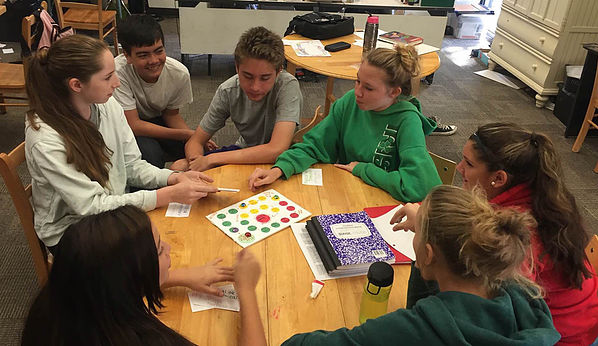Academics
School Performance
Curriculum
The Montessori curriculum is best described as an integration of subjects that spiral in depth of content over the span of the multi-age cycle within each program level. In addition to core subject areas of Geography, Geometry, History, Language Arts, Mathematics, and the branches of Science, Montessori education includes practical life lessons as well as peace education.
Geography
Even the youngest student in the Montessori classroom has experience with physical and cultural geography. First lessons with the globe provide primary program students with an awareness of the differentiation between the Earth’s water and the continents. The use of continent puzzle maps – present throughout the primary and elementary learning environments – provide further discovery of physical geography and offer a thematic focus for studying biomes and cultural geography. Early Secondary program students expand their knowledge of physical geography by developing a thorough understanding of the Earth’s geologic composition, which has affected its physical structure over time. At this program level, economic and cultural geography are also studied through the divergent lenses of history and current events, which provides opportunity to engage in scholarly debate.
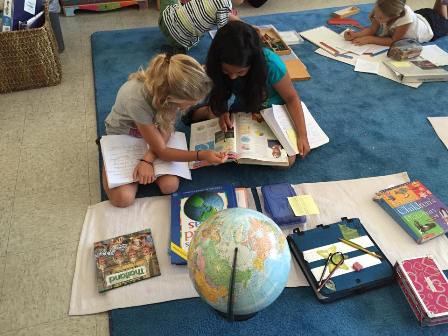
Geometry
The study of geometric shapes begins with concrete objects in the primary Montessori program, and carries forward throughout the Early Secondary program in a more abstract, complex and analytical manner. Identification and classification of plane figures and solid geometric shapes become the work of the primary Montessori student. Geometry studies for the elementary program level include definitions and properties of plane and solid shapes, and expanded forms of plane shapes (i.e. types of triangles and polygons). The study of nomenclature to describe specific aspects of geometric shapes is the work of elementary program level students, which lead to measurement and manipulation of shapes as they progress in their studies.
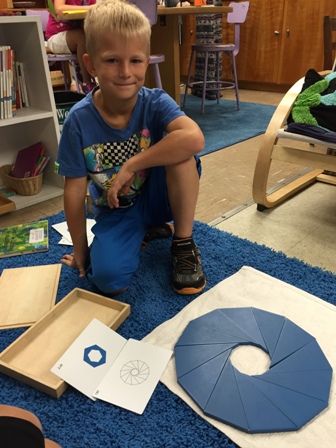
History
In a Montessori elementary classroom, the first lessons of history are presented in narrative form, beginning with the scientific theory of the origin of our universe. Dr. Montessori held firm to the belief that children whose imaginations were engaged would be more apt to learn. Studies of the history of our mother planet lend a strong connection to the science of zoology, and embedded in these studies is a component of the curriculum that provides the etymological origins of language. The study of early humans and how our species evolved is a concept that is presented throughout the elementary program years. Discussions on the fundamental needs of humans provide opportunities for the study of early civilizations and potential correlations to current day issues. The use of timelines is a key component of Montessori education, and enables students to place facts from any discipline in a linear progression. In this regard, history is not a separate subject, but a manner in which one organizes content in linear form.

Language Arts
Dr. Montessori understood that the sensitive period for developing language occurred from birth through approximately age six. It is for this reason that the primary environment holds a wealth of materials to provide experiences for the development of spoken and written language. Early lessons in phonemes form the basis of the language curriculum in the primary environment. Students experience letters and sounds through multi-modal forms of sandpaper letters, objects and modeling. Once the phonemic coding is in place, students build on their knowledge by using the moveable alphabet for word building and the study of phonemic blends for vocabulary development. Literacy is an integral component of all subject areas; nomenclature cards are prevalent throughout the Montessori curricula, and provide students with varying levels of matching words, objects and definitions. Instructional Guides at all program levels provide regular opportunities for listening to stories, which helps to build sustained focus and comprehension in pre-readers, and an appreciation for literary genres and the spoken word in older students. Composition is the written form of language, and is encouraged from the very first lessons of phonemic development. Formal instruction in handwriting emerges as a result of repeated practice with the sandpaper letters, which supports proper letter formation. As students progress in the Montessori program levels, they develop a wider working vocabulary (e.g. personal dictionaries), begin to study grammar (e.g. functions of the parts of speech), and take part in literature circles or shared reading groups to build skill in reading and critical thinking.
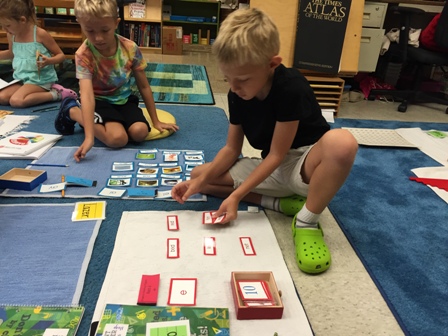
Mathematics
Dr. Montessori developed materials to teach a specific concept in practical form, and provided opportunity for independent exploration by making these materials self-correcting. The Montessori Math curriculum begins with concrete representation of quantity and symbol, and contains a variety of materials that progress in complexity of concept to enable students to move toward abstraction. Mathematics in the primary environment offers an introduction to the decimal system in an inviting and interactive form known as the Golden Bead Material. Young students begin composing numbers into the thousands through manipulation of the materials and in connection to the symbols presented by the Instructional Guide. The Bead Cabinet is also a learning tool introduced in the primary environment, but is used throughout the elementary program, as well. The Bead Cabinet is perhaps the most versatile Montessori Math material; for it provides students with a concrete form of linear counting that also incorporates skip counting, multiples, and the square and cube of numbers. The use of bead bars, which were developed in the same fashion as those in the Bead Cabinet are used throughout the elementary Math curriculum to support student learning of mathematical operations. As students become proficient with mathematical concepts, the reliance on representative materials subsides. Students in the Upper Elementary and Early Secondary learning environments are more able to complete their studies in abstract format, though there exist occasions when a return to the concrete materials is needed to reintroduce or reinforce a concept.

Branches of Science
The Montessori Science curriculum is interwoven with history, mathematics and language, and begins with a descriptive overview of the origin of our universe. Progressing from this first impressionistic lesson, students learn about types and formation of galaxies, the composition of stars, the planets that form our solar system, the formation of Earth, and the composition of our planet. Further lessons draw upon physical science concepts such as the states of matter, exploration of elements and compounds, and basic atomic theory. The study of plants and animals is also a part of the curricular web that flows through all Montessori program levels. Primary students learn classification of living and non-living organisms, and begin learning the differing characteristics of plants & animals. The Science curriculum progresses to identifying the parts of plants and animals, as well as more advanced classification of animals, and eventually to the biological characteristics that differentiate the propagation of animal species. Students in the elementary and early secondary program levels learn about the interrelationships of living organisms through lessons in ecology and environmental science, which also provide opportunity to study chemistry and revisit molecular theory. The branches of science are interrelated in the Montessori curriculum, and the progression of the spiral depth of knowledge is quite evident throughout the academic program levels.

Practical Life
Dr. Montessori held to the belief of education as an aid to life, and created activities for the young Montessori student that developed fine motor control, coordination and courtesy. While most of the practical life lessons are introduced in the Primary program and provide exercises in gaining fine motor precision, older Montessori students’ practical life activities expand to include real world activities. As the student sweeps up pencil shavings, in the active care for the school’s plants, or through the preparation of communal snack, Montessori students are developing independence in their environment.
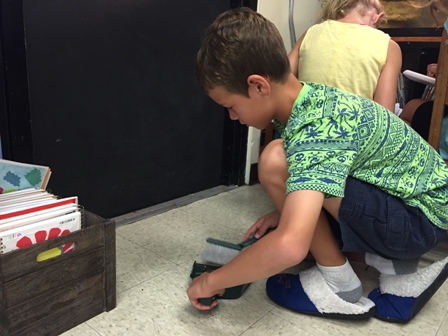
Peace Education
Early lessons in grace and courtesy provide the framework for a peaceful and connected learning environment. Students are guided in practical life activities that require sharing, taking turns, active listening, and respect. Students develop these characteristics through active participation in their environment and the classroom becomes a community of peacekeepers.

